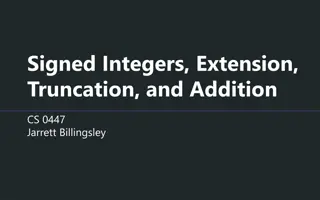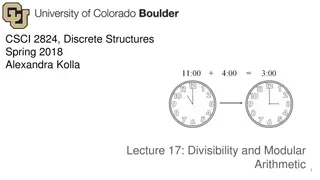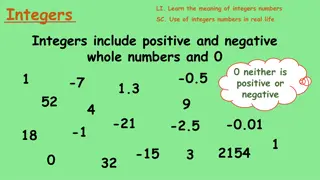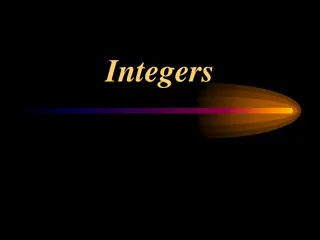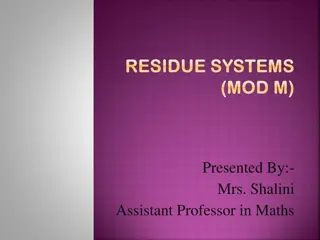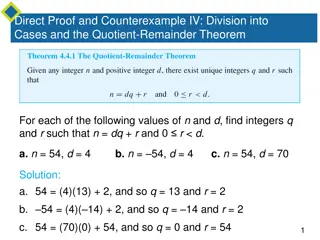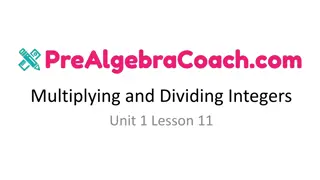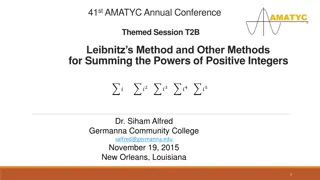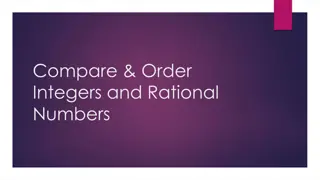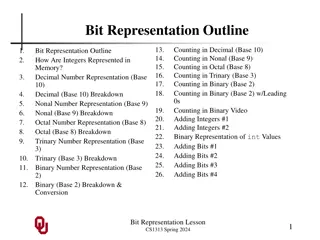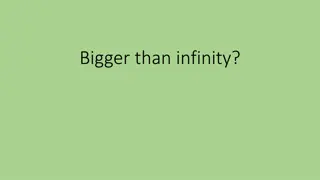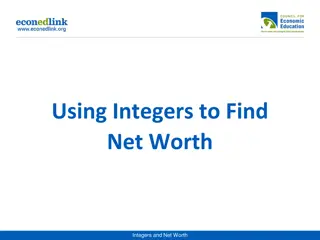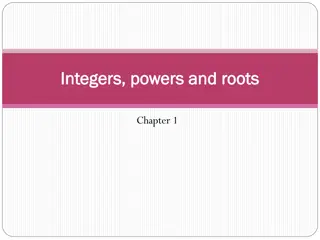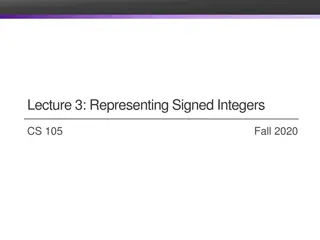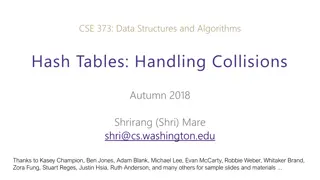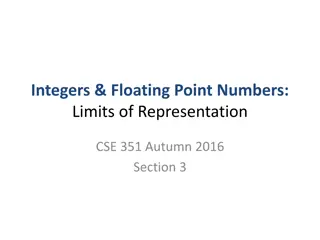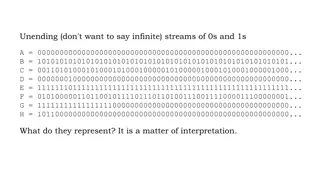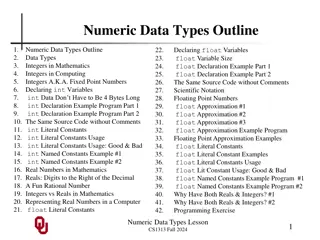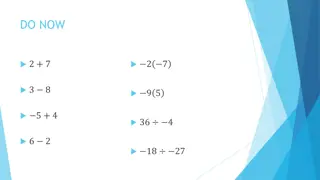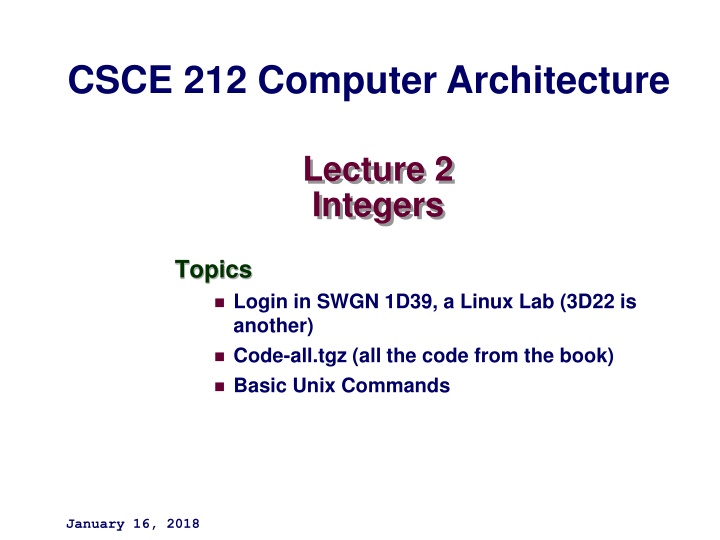
Understanding Integers Representation in Computer Architecture
Dive into the world of integers in computer architecture, exploring topics such as two's complement representation, sign extension, and rules for expanding and truncating integer values. Learn how to convert between different integer data types and understand the nuances of representing both signed and unsigned numbers.
Download Presentation

Please find below an Image/Link to download the presentation.
The content on the website is provided AS IS for your information and personal use only. It may not be sold, licensed, or shared on other websites without obtaining consent from the author. If you encounter any issues during the download, it is possible that the publisher has removed the file from their server.
You are allowed to download the files provided on this website for personal or commercial use, subject to the condition that they are used lawfully. All files are the property of their respective owners.
The content on the website is provided AS IS for your information and personal use only. It may not be sold, licensed, or shared on other websites without obtaining consent from the author.
E N D
Presentation Transcript
CSCE 212 Computer Architecture Lecture 2 Integers Topics Login in SWGN 1D39, a Linux Lab (3D22 is another) Code-all.tgz (all the code from the book) Basic Unix Commands January 16, 2018
Overview Last Time Lec01 slides 1-? Course Pragmatics Website http://www.cse.sc.edu/~matthews/Courses/212/index.html Text - "Computer Systems: A Programmer's Perspective" 3rd ed Ints are not integers; floats are not reals; unsigned are Z mod 2w Today Slides 29- from Lec01 Two s Complement formal notation Two s Complement representation (from text) -1 on highest bit Two s Complement representation (take 2) To represent a positive number - same as signed magnitude To represent a negative number take two s complement of magnitude 2 CSCE 212H Spring 2018
Review Values represented by int Representations Unsigned w 1 xi 2i = B2U(X) i=0 Signed Magnitude 2 s complement w 2 xw 1 2w 1+ xi 2i = B2T(X) i=0 3 CSCE 212H Spring 2018
Sign Extension Task: Given w-bit signed integer x Convert it to w+k-bit integer with same value Rule: Make k copies of sign bit: X = xw 1 , , xw 1 , xw 1 , xw 2 , , x0 w k copies of MSB X X k w 4 CSCE 212H Spring 2018
Sign Extension Example short int x = 15213; int ix = (int) x; short int y = -15213; int iy = (int) y; Decimal 15213 15213 -15213 -15213 Hex Binary x ix y iy 3B 6D 00111011 01101101 00 00 3B 6D 00000000 00000000 00111011 01101101 C4 93 11000100 10010011 FF FF C4 93 11111111 11111111 11000100 10010011 Converting from smaller to larger integer data type C automatically performs sign extension 5 CSCE 212H Spring 2018
Summary: Expanding, Truncating: Basic Rules Expanding (e.g., short int to int) Unsigned: zeros added Signed: sign extension Both yield expected result Truncating (e.g., unsigned to unsigned short) Unsigned/signed: bits are truncated Result reinterpreted Unsigned: mod operation Signed: similar to mod For small numbers yields expected behavior 6 CSCE 212H Spring 2018
Unsigned Addition u v Operands: w bits + True Sum: w+1 bits u + v UAddw(u , v) Discard Carry: w bits Standard Addition Function Ignores carry output Implements Modular Arithmetic s = UAddw(u , v) = u + v mod 2w 7 CSCE 212H Spring 2018
Visualizing (Mathematical) Integer Addition Integer Addition 4-bit integers u, v Compute true sum Add4(u , v) Values increase linearly with u and v Forms planar surface Add4(u , v) Integer Addition 32 28 24 20 16 14 12 12 10 8 8 4 6 v 0 4 0 2 u 2 4 6 8 0 10 12 14 8 CSCE 212H Spring 2018
Visualizing Unsigned Addition Wraps Around If true sum 2w At most once Overflow UAdd4(u , v) 16 True Sum 14 2w+1 12 Overflow 10 8 14 2w 6 12 10 4 8 v 2 6 0 0 4 Modular Sum 0 u 2 2 4 6 8 0 10 12 14 9 CSCE 212H Spring 2018
Twos Complement Addition u v Operands: w bits + True Sum: w+1 bits u + v TAddw(u , v) Discard Carry: w bits TAdd and UAdd have Identical Bit-Level Behavior Signed vs. unsigned addition in C: int s, t, u, v; s = (int) ((unsigned) u + (unsigned) v); t = u + v Will gives == t 10 CSCE 212H Spring 2018
TAdd Overflow Functionality True sum requires w+1 bits Drop off MSB Treat remaining bits as 2 s comp. integer True Sum 0111 1 2w 1 PosOver TAdd Result 0100 0 2w 1 1 011 1 0000 0 0 000 0 1011 1 2w 1 100 0 NegOver 1000 0 2w 11 CSCE 212H Spring 2018
Visualizing 2s Complement Addition NegOver Values 4-bit two s comp. Range from -8 to +7 TAdd4(u , v) Wraps Around If sum 2w 1 Becomes negative At most once 8 6 4 2 0 6 -2 4 2 -4 0 -6 -2 -8 v -4 If sum < 2w 1 Becomes positive At most once -8 -6 -6 -4 -2 0 -8 2 4 PosOver u 6 12 CSCE 212H Spring 2018
Multiplication Goal: Computing Product of w-bit numbers x, y Either signed or unsigned But, exact results can be bigger than w bits Unsigned: up to 2w bits Result range: 0 x * y (2w 1) 2 = 22w 2w+1 + 1 Two s complement min (negative): Up to 2w-1 bits Result range: x * y ( 2w 1)*(2w 1 1) = 22w 2 + 2w 1 Two s complement max (positive): Up to 2w bits, but only for (TMinw)2 Result range: x * y ( 2w 1) 2 = 22w 2 So, maintaining exact results would need to keep expanding word size with each product computed 13 CSCE 212H Spring 2018
Unsigned Multiplication in C u v Operands: w bits * u v True Product: 2*w bits UMultw(u , v) Discard w bits: w bits Standard Multiplication Function Ignores high order w bits Implements Modular Arithmetic UMultw(u , v) = u v mod 2w 14 CSCE 212H Spring 2018
Signed Multiplication in C u v Operands: w bits * u v True Product: 2*w bits TMultw(u , v) Discard w bits: w bits Standard Multiplication Function Ignores high order w bits Some of which are different for signed vs. unsigned multiplication Lower bits are the same 15 CSCE 212H Spring 2018
Power-of-2 Multiply with Shift Operation u << k gives u * 2k Both signed and unsigned k u 2k Operands: w bits * 0 0 1 0 0 0 u 2k True Product: w+k bits 0 0 0 UMultw(u , 2k) TMultw(u , 2k) Discard k bits: w bits 0 0 0 Examples u << 3 (u << 5) (u << 3) == Most machines shift and add faster than multiply Compiler generates this code automatically == u * 8 u * 24 16 CSCE 212H Spring 2018
Unsigned Power-of-2 Divide with Shift Quotient of Unsigned by Power of 2 u >> k gives u / 2k Uses logical shift k u 2k Binary Point Operands: / 0 0 1 0 0 0 u / 2k . 0 0 0 0 Division: u / 2k 0 0 0 0 Result: x x >> 1 x >> 4 x >> 8 Division 15213 7606.5 950.8125 59.4257813 Computed 15213 Hex 3B 6D 00111011 01101101 1D B6 00011101 10110110 03 B6 00000011 10110110 00 3B 00000000 00111011 Binary 7606 950 59 17 CSCE 212H Spring 2018
Arithmetic: Basic Rules Addition: Unsigned/signed: Normal addition followed by truncate, same operation on bit level Unsigned: addition mod 2w Mathematical addition + possible subtraction of 2w Signed: modified addition mod 2w (result in proper range) Mathematical addition + possible addition or subtraction of 2w Multiplication: Unsigned/signed: Normal multiplication followed by truncate, same operation on bit level Unsigned: multiplication mod 2w Signed: modified multiplication mod 2 (result in proper 18 CSCE 212H Spring 2018
Why Should I Use Unsigned? Don t use without understanding implications Easy to make mistakes unsigned i; for (i = cnt-2; i >= 0; i--) a[i] += a[i+1]; Can be very subtle #define DELTA sizeof(int) int i; for (i = CNT; i-DELTA >= 0; i-= DELTA) . . . 19 CSCE 212H Spring 2018
Counting Down with Unsigned Proper way to use unsigned as loop index unsigned i; for (i = cnt-2; i < cnt; i--) a[i] += a[i+1]; See Robert Seacord, Secure Coding in C and C++ C Standard guarantees that unsigned addition will behave like modular arithmetic 0 1 UMax Even better size_t i; for (i = cnt-2; i < cnt; i--) a[i] += a[i+1]; Data type size_t defined as unsigned value with length = word size Code will work even if cnt = UMax 20 CSCE 212H Spring 2018
Why Should I Use Unsigned? (cont.) Do Use When Performing Modular Arithmetic Multiprecision arithmetic Do Use When Using Bits to Represent Sets Logical right shift, no sign extension 21 CSCE 212H Spring 2018
Byte-Oriented Memory Organization Programs refer to data by address Conceptually, envision it as a very large array of bytes In reality, it s not, but can think of it that way An address is like an index into that array and, a pointer variable stores an address Note: system provides private address spaces to each process Think of a process as a program being executed 22 So, a program can clobber its own data, but not that of others CSCE 212H Spring 2018
Machine Words Any given computer has a Word Size Nominal size of integer-valued data and of addresses Until recently, most machines used 32 bits (4 bytes) as word size Limits addresses to 4GB (232 bytes) Increasingly, machines have 64-bit word size Potentially, could have 18 PB (petabytes) of addressable memory That s 18.4 X 1015 Machines still support multiple data formats Fractions or multiples of word size 23 CSCE 212H Spring 2018
Word-Oriented Memory Organization 32-bit Words 64-bit Words Bytes Addr. Addresses Specify Byte Locations Address of first byte in word Addresses of successive words differ by 4 (32-bit) or 8 (64-bit) 0000 0001 0002 0003 0004 0005 0006 0007 0008 0009 0010 0011 0012 0013 0014 0015 Addr = ?? 0000 Addr = ?? 0000 Addr = ?? 0004 Addr = ?? 0008 Addr = ?? 0008 Addr = ?? 0012 24 CSCE 212H Spring 2018
Example Data Representations C Data Type Typical 32-bit Typical 64-bit x86-64 char 1 1 1 short 2 2 2 int 4 4 4 long 4 8 8 float 4 4 4 double 8 8 8 long double 10/16 pointer 4 8 8 25 CSCE 212H Spring 2018
Byte Ordering So, how are the bytes within a multi-byte word ordered in memory? Conventions Big Endian: Sun, PPC Mac, Internet Least significant byte has highest address Little Endian: x86, ARM processors running Android, iOS, and Windows Least significant byte has lowest address 26 CSCE 212H Spring 2018
Byte Ordering Example Example Variable x has 4-byte value of 0x01234567 Address given by &x is 0x100 Big Endian 0x100 0x101 0x102 0x103 01 23 01 23 45 45 67 67 Little Endian 0x100 0x101 0x102 0x103 67 45 67 45 23 23 01 01 27 CSCE 212H Spring 2018
Representing Integers Decimal: 15213 Binary: 0011 1011 0110 1101 Hex: 3 B 6 D int A = 15213; long int C = 15213; IA32, x86-64 Sun IA32 x86-64 Sun 6D 3B 00 00 00 00 6D 3B 00 00 6D 3B 00 00 00 00 3B 6D 3B 6D 00 00 00 00 int B = -15213; IA32, x86-64 Sun 93 C4 FF FF FF FF C4 93 Two s complement representation 28 CSCE 212H Spring 2018
Examining Data Representations Code to Print Byte Representation of Data Casting pointer to unsigned char * allows treatment as a byte array typedef unsigned char *pointer; void show_bytes(pointer start, size_t len){ size_t i; for (i = 0; i < len; i++) printf( %p\t0x%.2x\n",start+i, start[i]); printf("\n"); } Printf directives: %p: Print pointer %x: Print Hexadecimal 29 CSCE 212H Spring 2018
show_bytes Execution Example int a = 15213; printf("int a = 15213;\n"); show_bytes((pointer) &a, sizeof(int)); Result (Linux x86-64): int a = 15213; 0x7fffb7f71dbc 0x7fffb7f71dbd 0x7fffb7f71dbe 0x7fffb7f71dbf 6d 3b 00 00 30 CSCE 212H Spring 2018
Representing Pointers int B = -15213; int *P = &B; Sun IA32 x86-64 EF AC 3C FF 28 1B FB F5 FE 2C FF 82 FD 7F 00 00 Different compilers & machines assign different locations to objects 31 Even get different results each time run program CSCE 212H Spring 2018
Representing Strings char S[6] = "18213"; Strings in C Represented by array of characters Each character encoded in ASCII format Standard 7-bit encoding of character set Character 0 has code 0x30 Digit i i has code 0x30+i i String should be null-terminated Final character = 0 IA32 Sun 31 31 38 38 32 32 31 31 33 33 00 00 Compatibility Byte ordering not an issue 32 CSCE 212H Spring 2018
Integer C Puzzles x < 0 ux >= 0 x & 7 == 7 ux > -1 x > y x * x >= 0 x > 0 && y > 0 x >= 0 x <= 0 (x|-x)>>31 == -1 ux >> 3 == ux/8 x >> 3 == x/8 x & (x-1) != 0 ((x*2) < 0) (x<<30) < 0 -x < -y x + y > 0 -x <= 0 -x >= 0 Initialization int x = foo(); int y = bar(); unsigned ux = x; unsigned uy = y; 33 CSCE 212H Spring 2018
Application of Boolean Algebra Applied to Digital Systems by Claude Shannon 1937 MIT Master s Thesis Reason about networks of relay switches Encode closed switch as 1, open switch as 0 A&~B Connection when A&~B | ~A&B A ~B ~A B = A^B ~A&B 34 CSCE 212H Spring 2018
35 CSCE 212H Spring 2018

